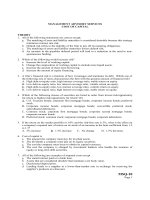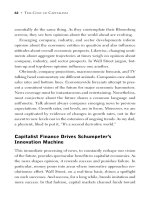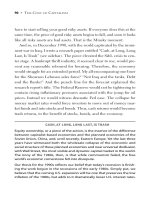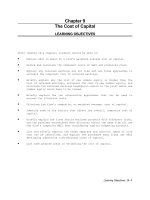Chapter 11 the cost of capital
Bạn đang xem bản rút gọn của tài liệu. Xem và tải ngay bản đầy đủ của tài liệu tại đây (660.39 KB, 28 trang )
PowerPoint
to accompany
Chapter 11
The Cost Of
Capital
Learning Goals:
• Understand the cost of capital and the specific
sources of capital associated with the cost of capital.
• Determine the cost of debt and preference share
capital.
• Calculate cost of ordinary share capital, convert to
cost of new ordinary shares and cost of retained
earnings.
• Find the weighted average cost of capital and discuss
the alternative weighting schemes available.
Describe the procedures used to determine break
points and the weighted marginal cost of capital.
Explain the weighted marginal cost of capital and its
use with the investment opportunities schedule to
make financing/investment decisions.
Copyright © 2011 Pearson Australia (a division of Pearson Australia Group Pty Ltd) –
9781442518193/ Gitman et al / Principles of Managerial Finance / 6th edition
The Cost Of Capital
The rate of return a firm must earn on its project
investments to maintain the market value of its
shares and attract investors.
Is affected by a variety of economic and firm
factors.
Is estimated at a given point in time.
Reflects the expected average future cost of funds
over the long run based on available information.
Should reflect the interrelatedness of financing
activities.
Copyright © 2011 Pearson Australia (a division of Pearson Australia Group Pty Ltd) –
9781442518193/ Gitman et al / Principles of Managerial Finance / 6th edition
Specific Sources Of Capital
Focus is on long term sources of funds available.
Four basic sources:
1. Debt
2. Preference Shares
3. Ordinary Shares
4. Retained Earnings
Copyright © 2011 Pearson Australia (a division of Pearson Australia Group Pty Ltd) –
9781442518193/ Gitman et al / Principles of Managerial Finance / 6th edition
The Cost Of Long Term Debt
The after tax cost today of raising long term funds
through borrowing.
Assumes funds are raised through the issuance and
sale or long term bonds or debentures.
Net Proceeds: The funds actually received from the
sale of a security.
Flotation Costs: The costs of issuing and selling a
security. Flotation costs consist of two components:
• Underwriting costs
• Administrative costs
Copyright © 2011 Pearson Australia (a division of Pearson Australia Group Pty Ltd) –
9781442518193/ Gitman et al / Principles of Managerial Finance / 6th edition
Before Tax Cost Of Debt
Calculation: Involves calculating the internal rate of return of the
bond cash flows.
Approximation: For a bond with a $1,000 par value the before tax
cost of debt can be approximated by:
[Equation 11.1]
$1,000 N d
I n
rd N d $1,000
Where: 2
I = Annual interest in dollars
Nd = Net proceeds from the sale of debt (bond)
n = Number of years to the bond’s maturity
Copyright © 2011 Pearson Australia (a division of Pearson Australia Group Pty Ltd) –
9781442518193/ Gitman et al / Principles of Managerial Finance / 6th edition
Before Tax Cost Of Debt
Duchess Limited, a major hardware manufacturer, is
contemplating selling $10 million worth of 20 year, 9%
coupon bonds, each with a face value of $1,000. Since
similar risk bonds earn returns greater than 9%, the firm
must sell the bonds for $980 to compensate for the lower
coupon interest rate. The flotation costs paid to the
investment banker are 2% of the face value of the bond.
Calculation Method:
Financial Calculator:
n = 20, PV = 960, PMT = -90, FV = 1,000
i = 9.542
Copyright © 2011 Pearson Australia (a division of Pearson Australia Group Pty Ltd) –
9781442518193/ Gitman et al / Principles of Managerial Finance / 6th edition
Before Tax Cost Of Debt
Calculation Method Continued:
Formula:
Trial and error
Approximation Method:
I $1,000 N d
n
rd N d $1,000
2
$90 $1,000 $960
20
rd $960 $1,000
2
rd = 0.0094 or 9.4%
Copyright © 2011 Pearson Australia (a division of Pearson Australia Group Pty Ltd) –
9781442518193/ Gitman et al / Principles of Managerial Finance / 6th edition
After Tax Cost Of Capital
Abbreviated as ri.
Calculated by:
ri rd (1 T ) [Equation 11.2]
Where:
T = Applicable tax rate
Duchess Limited has a 30% tax rate. Using the
9.4% before tax cost of debt previously calculated
we can calculate the after tax cost of debt:
ri = 0.0094 x (1 – 0.30)
ri = 0.00658 or 6.58%
Copyright © 2011 Pearson Australia (a division of Pearson Australia Group Pty Ltd) –
9781442518193/ Gitman et al / Principles of Managerial Finance / 6th edition
Cost Of Preference Share
Capital
Abbreviated as rp.
Calculated by:
rp Dp [Equation 11.3]
Np
Where:
Dp = Annual preference dividend
Np = Net proceeds from the sale of preference
shares
Copyright © 2011 Pearson Australia (a division of Pearson Australia Group Pty Ltd) –
9781442518193/ Gitman et al / Principles of Managerial Finance / 6th edition
Cost Of Preference Share
Capital
Duchess Limited is considering the issue of 12%
preference shares with an issue price of $100 per
share. The costs of issuing and marketing the
shares, the flotation costs, are expected to be $4
per share.
rp Dp
Np
rp = $12.00
$96.00
rp = 12.5%
Copyright © 2011 Pearson Australia (a division of Pearson Australia Group Pty Ltd) –
9781442518193/ Gitman et al / Principles of Managerial Finance / 6th edition
Calculating The Cost Of Already
Issued Preference Capital
Calculated by:
[ErquatioDnp11.4]
p
P
Where:
rp = Cost of preference share capital
P = Market value of preference share capital
If the market value of Duchess Limited’s previously
issued share capital is $10 million and the preference
dividend payable is $1.2 million, the cost of preference
share capital is:
rp = $1,200,000
$10,000,000
rp = 12%
Copyright © 2011 Pearson Australia (a division of Pearson Australia Group Pty Ltd) –
9781442518193/ Gitman et al / Principles of Managerial Finance / 6th edition
Cost Of Ordinary Share Equity
Capital
Abbreviated as rs.
The rate at which investors discount the
expected dividends of the firm to determine its
share value.
Can take two forms:
1. Retained earnings
2. New issues of ordinary shares
Copyright © 2011 Pearson Australia (a division of Pearson Australia Group Pty Ltd) –
9781442518193/ Gitman et al / Principles of Managerial Finance / 6th edition
Finding The Cost Of Ordinary
Share Equity Capital
Two techniques:
1. Constant Growth Valuation (Gordon) Model
Calculated by:
[ErsquaDtio1 n1g1.6]
P0
Where:
P0 = Value of one ordinary share
D1 = Per share dividend expected at the end of
year 1
Rs = Cost of ordinary share capital
g = Constant rate of growth of dividends
Copyright © 2011 Pearson Australia (a division of Pearson Australia Group Pty Ltd) –
9781442518193/ Gitman et al / Principles of Managerial Finance / 6th edition
Finding The Cost Of Ordinary
Share Equity Capital
2. Capital Asset Pricing Model (CAPM)
Calculated by:
[EquarstionRF11[.b7](rm RF )]
Despite the fact that it does not directly address
risk, the constant growth model is more commonly
used in practice due to its ease of calculation,
availability of data and ease of adjustment for
flotation costs when calculating the cost of new
ordinary share capital.
Copyright © 2011 Pearson Australia (a division of Pearson Australia Group Pty Ltd) –
9781442518193/ Gitman et al / Principles of Managerial Finance / 6th edition
Finding The Cost Of Ordinary
Share Equity Capital
Cost Of Retained Earnings:
Abbreviated as rr.
Is the same as the cost of an equivalent fully
subscribed issue of additional equity. Therefore:
rr = rs [Equation 11.8]
No adjustment is required for flotation costs.
Copyright © 2011 Pearson Australia (a division of Pearson Australia Group Pty Ltd) –
9781442518193/ Gitman et al / Principles of Managerial Finance / 6th edition
Finding The Cost Of Ordinary
Share Equity Capital
Cost Of New Issues Of Ordinary Share Equity:
Abbreviated as rn.
Is calculated net of underpricing and flotation costs.
Will always be greater than the cost of existing
issues/retained earnings, and the greatest long term
financing cost option.
Calculated using the constant growth model:
rn [EqDu1atiogn 11.9]
Nn
Where:
Nn = Net proceeds from the sale of new shares.
Copyright © 2011 Pearson Australia (a division of Pearson Australia Group Pty Ltd) –
9781442518193/ Gitman et al / Principles of Managerial Finance / 6th edition
Weighted Average Cost Of
Capital
Abbreviated as ra.
Reflects the expected average future cost of funds over the
long run.
Calculated by:
ra = (ri x wi) + (rp x wp) + (rr or n x ws) [Equation 11.10]
Where:
wi = Proportion of long term debt in the capital structure
wp = Proportion of preference share capital in the capital
structure
ws = Proportion of ordinary share equity in the capital
structure.
Copyright © 2011 Pearson Australia (a division of Pearson Australia Group Pty Ltd) –
9781442518193/ Gitman et al / Principles of Managerial Finance / 6th edition
Weighted Average Cost Of
Capital
Duchess Limited has calculated the costs of the
various types of capital to be:
The company uses the following weights in
calculating WACC:
Copyright © 2011 Pearson Australia (a division of Pearson Australia Group Pty Ltd) –
9781442518193/ Gitman et al / Principles of Managerial Finance / 6th edition
Weighted Average Cost Of
Capital
Because the firm expects to have a sizeable amount of
retained earnings available ($300,000), it plans to use its
cost of retained earnings as the cost of ordinary share
capital.
Page 488.
Assuming an unchanged risk level, the firm should
accept all projects that earn a return greater than or
equal to 10.38%.
Copyright © 2011 Pearson Australia (a division of Pearson Australia Group Pty Ltd) –
9781442518193/ Gitman et al / Principles of Managerial Finance / 6th edition









